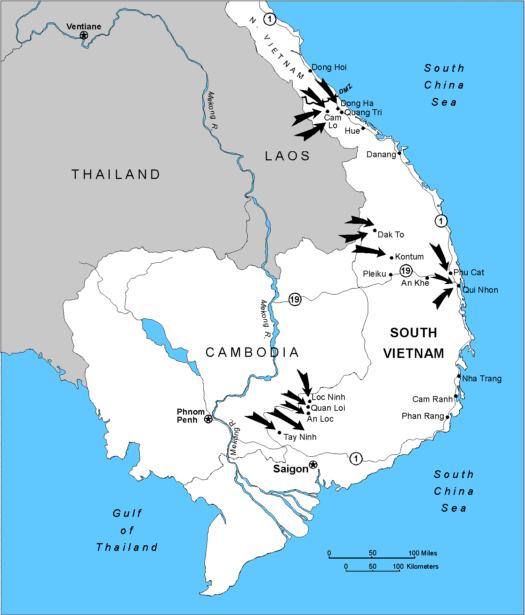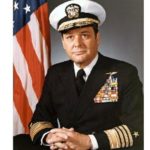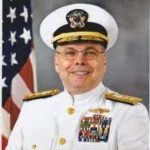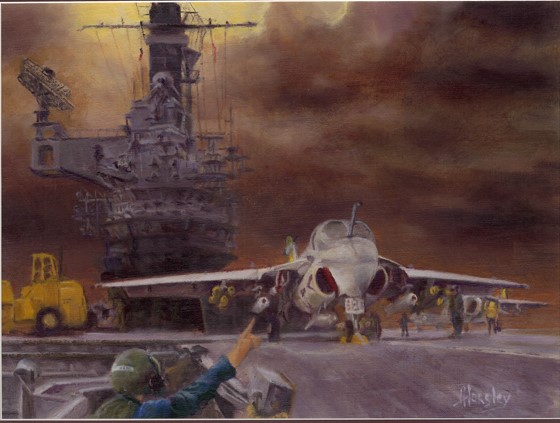War and Remembrance
The actions of Navy aircraft and surface ships in defeating the NVA offensive arguably represent one of the U.S. Navy’s finest hours since World War II.
Rear Admiral Samuel Cox (USN, Ret), Director of the Naval History and Heritage Command
VA-115 Intruder preparing to launch from USS Midway for a night mission into Vietnam during Linebacker. Painting by 115 pilot Jim Horsely
Remembersky was first posted ten years ago with intent to fill in a perceived gap in Vietnam War stories in regard to USS Midway, Carrier Airwing Five, and in particular the air-ground missions in response to the 1972 Easter Offensive. Midway and its airwing had set the record for most days for a carrier on-line in the Gulf of Tonkin and was only one of four carriers to receive the Presidential Unit Citation in that war. And yet, reading multiple books and articles revealed limited stories. There are currently 42 offerings including ten focused on Operation Homecoming and the POW return, the collection captured in Anthology – RememberedSky Vietnam Air War ’72-’73 Stories.
This site is about the collection of stories and given that 2022 marks the 50th anniversary of the Easter Offensive and Operation Linebacker I &II, it seems appropriate to offer up sea stories of that timeframe on a broader front. Along the way, H-Grams from Naval History and Heritage Command have been a constant source for great stories and history for Rememberedsky. I highly recommend your reading of the current H-Grams by Admiral/Director Samuel Cox:
- H-Gram 070: The Easter Offensive—Vietnam 1972 (1)
- H-070-1: The Vietnam War Easter Offensive, Part 1
- H-Gram 074: The Easter Offensive—Vietnam 1972 (2)
- H-074-1: The Easter Offensive—Vietnam 1972, Part 2
Below are summaries to these recent H-Grams in regard to the anniversary of the North Vietnamese 30 March 1972 large scale invasion of South Vietnam, and the subsequent U.S. Linebacker I and II operations.
H-Gram 070: The Easter Offensive—Vietnam 1972 (1)
27 April 2022
This H-gram covers the massive 1972 North Vietnamese “Easter Offensive” into South Vietnam, during which aircraft from six U.S. Navy aircraft carriers, along with  naval gunfire support, played a critical role in beating back the attack and preventing the collapse of the South Vietnamese government. It also details the initiation of Operation Pocket Money, the extensive Navy aerial mining campaign to shut down Haiphong and North Vietnamese ports from Soviet and Chinese supply. Finally, it covers the initiation of an extensive bombing campaign of North Vietnam, Operation Linebacker, which had been suspended since the end of Operation Rolling Thunder in 1968. The first day of Linebacker resulted in the largest air-to-air battle of the war, and the first U.S. aces of the war.
naval gunfire support, played a critical role in beating back the attack and preventing the collapse of the South Vietnamese government. It also details the initiation of Operation Pocket Money, the extensive Navy aerial mining campaign to shut down Haiphong and North Vietnamese ports from Soviet and Chinese supply. Finally, it covers the initiation of an extensive bombing campaign of North Vietnam, Operation Linebacker, which had been suspended since the end of Operation Rolling Thunder in 1968. The first day of Linebacker resulted in the largest air-to-air battle of the war, and the first U.S. aces of the war.
The first strikes of the Linebacker campaign took place on 10 May and included the epic strike on the Hai Duong railroad yard by Constellation/CVW-9 aircraft. The railroad yard was devastated, but the strike was jumped by two dozen or more MiG fighters. This resulted in the largest air-to-air battle of the war, including some of the most amazing escapes by A-7 and A-6 aircraft. One F-4 was downed by AAA. Six MiGs were shot down during the engagement, during which an F-4 flown by Lieutenant Randall “Duke” Cunningham and radar intercept officer (RIO) Lieutenant (j.g.) William “Irish” Driscoll downed their third, fourth and fifth MiG (making them the first American air aces of the war) before they were shot down by an SA-2 SAM while egressing.
For the rest of May and June 1972, Navy aircraft from six carriers and gunfire from more than two dozen surface combatants pummeled North Vietnamese troops and installations the length of North and South Vietnam, inflicting thousands of NVA casualties in the south and destroying numerous previously “off-limits” targets in the north. The mining operation had immediate effect, as the NVA in South Vietnam began to conserve air defense ammunition and missiles. Although the NVA would hold Quang Tri until September, the offensives at An Loc and Kontum culminated by mid-June and ARVN troops began to push the NVA back, thanks to U.S. air power (and significant ARVN courage).
Linebacker 1 would continue into the fall and Pocket Money until the peace accords were signed in early 1973. The rest of the considerable U.S. Navy action in 1972 will be covered in a future H-gram. The actions of Navy aircraft and surface ships in defeating the NVA offensive arguably represent one of the U.S. Navy’s finest hours since World War II. More detail on more amazing actions can be found in attachment H-070-1 (summarized below):
H-070-1:
U.S. Navy aircraft flew 3,949 attack sorties into North Vietnam in May compared to 1,250 in April. U.S. Navy attack sorties into South Vietnam dropped from 4,833 in April to 3,290 in May. This was compensated for by an increase in Marine sorties in the South from 543 in April to 1,502 in May with the arrival of more Marine aircraft in-country. U.S. Navy aircraft struck 2,416 targets in North Vietnam in May, up from 719 in April. Target categories included railroads (16 percent), roads and trucks (14 percent), storage areas (13 percent), and bridges (10 percent). U.S. Navy aircraft shot down 16 North Vietnamese jets in May, including 11 MiG-17 Frescoes, two MiG-19 Farmers, and three MiG-21 Fishbeds. The U.S. Navy lost six aircraft in May, two F-4 Phantom IIs and two A-7 Corsair IIs to antiaircraft artillery (AAA) and SA-2 surface-to-air missiles. One F-8 Crusader and one RA-5 Vigilante were lost to unknown causes, but none were believed to be due to enemy fighters. Some of the events covered:
- The draw down in early 1972
- January MiG events
- 21 February: Nixon Visits China
- 29 February: Three Carriers on Yankee Station (Two On, One Off)
- 10 March: “Protective Reaction” Strikes
- 30 March, the Easter Offensive Begins
- More Carriers
- A Busy April: B-52 strikes, surface action, An Loc
- MiGs in May
- 8 May: President Richard Nixon Orders Mining and Bombing Escalation
- Pocket Money
- 10 May: Execution of Operation Linebacker
- LB first operations
H-074: The Easter Offensive—Vietnam 1972, Part 2
6 September 2022
This H-gram continues where H-Gram 070 left off and covers the period of the Vietnam War between 1 July and 1 October 1972, as U.S. Navy carrier aircraft continued strikes into North Vietnam as part of Operation Linebacker and continued aerial minelaying operations in North Vietnamese harbors and coastal waters. H-Gram 074 also covers (future CNO) Vice Admiral James L. Holloway’s joy ride through Haiphong Harbor in August 1972—seriously, Operation Lion’s Den was one of the most audacious and dangerous surface actions since World War II.
through Haiphong Harbor in August 1972—seriously, Operation Lion’s Den was one of the most audacious and dangerous surface actions since World War II.
As of the beginning of July 1972, the U.S. Navy had six attack aircraft carriers flying strike missions against targets in North Vietnam as part of Operation Linebacker, and against North Vietnamese forces in South Vietnam, which had launched a massive conventional ground invasion of the South beginning 30 March. This was the largest concentration of carrier airpower amassed since World War II (and equaled only by the Desert Storm deployments in 1990/91). These carriers, along with two that had been relieved and had departed, played a critical role in first blunting the North Vietnamese offensive and then pushing it back, especially in the early days when carrier aircraft (and long-range B-52 Arc Light missions) were the only game in town until the U.S. Air Force could build back up its strength at bases in Thailand and the Marines got planes back into bases in South Vietnam. For more detail on the war in Vietnam from July to October 1972, please see attachment H-074-1.
H-074-1:
Following the significant aerial battles at the inception of Operation Linebacker in May, and heavy losses by the North Vietnamese air force, enemy air activity dropped off in July and even more so in August, as did launches of surface-to-air missiles. The older North Vietnamese MiG-17 and Mig-19 aircraft declined to engage. In fact, the only North Vietnamese aircraft even sighted in the air in July and August were the newer MiG-21 Fishbeds, and then only a very few of them. A major factor in the drop-off in air activity and SAM launches was the effect of finally mining North Vietnamese ports, which quickly caused the North Vietnamese to begin conserving ammunition as their previously unimpeded avenue of resupply from the Soviet Union and Communist China was cut off. Navy leaders, who had unsuccessfully advocated for mining the ports for years, refrained from publicly saying, “We told you so.” Some of the events covered:
- 17 July: USS Warrington Damaged by U.S. Mines
- 18 July: Jane Fonda’s Most Unforgettable Role
- 19 July: Biddle’s Surface-to-Air Engagement
- 20 July: USS Oriskany’s Loose Screw
- 6 August: Deepest SAR Rescue Since 1968
- 27 August 1972: Operation Lion’s Den: The Battle of Haiphong Harbor
- 1 October: USS Newport News Turret Explosion
During August 1972, Navy aircraft flew 4,819 sorties into North Vietnam. There was also a sharp rise in U.S. Marine Corps (USMC) sorties from bases in South Vietnam striking enemy targets in the Mekong Delta area of South Vietnam. In the month of September 1972, U.S. Navy aircraft flew 3,934 combat sorties in North Vietnam and 1,708 in South Vietnam. USMC aircraft flew 1,296 sorties, mostly from airfields in South Vietnam against enemy targets in South Vietnam.
The next Vietnam H-gram will cover the period October 1972 to February 1973, and will include:
- “Snuffy” Smith taking down the Thanh Hoa (“Dragon’s Jaw”) bridge
- Race riot on Kitty Hawk
- Agreement for ceasefire and end to Operation Linebacker
- SEAL Michael Thornton’s Medal of Honor
- Collapse of the Paris Peace Talks
- Operation Linebacker II “Christmas Bombing Campaign”
- CSAR for CO of VMFA-333
- Last air-to-air engagements and losses
- Agreement for “Peace with Honor”
- Release of U.S. POWs—Operation Homecoming
- Plus
Summary of U.S. Navy role in Vietnam
*************************
Background – In November 2016, Director Naval History and Heritage Command, Samuel J. Cox (RADM, USN Ret) initiated a series of “H-grams.” Inspired by the late Admiral Zumwalt’s series of Z-grams used to communicate with sailors throughout the Navy, H-grams are an avenue by which NHHC provides significant historical context to aid today’s decision-makers. H-grams and associated attachments reflect Director Cox’s personal assessment, aided by NHHC historians, of significant events in U.S. Navy history. Each H-gram draws on archival material, historic imagery, and written and oral history and emphasizes the importance of honoring the service of sailors throughout history and understanding the relevance of the past to today’s Navy. Previous H-grams can be found on the H-gram archives page.
 Rear Admiral (retired) Sam Cox has served as the Director of the Naval History and Heritage Command since 2014. He is responsible for the Navy’s official history programs, operational archives, Navy Department Library, and the Navy’s collection of historic artifacts, photographs, art, weapons, and 1,100 display aircraft, and for the underwater archaeology program. He is also responsible for ten official U.S. Navy museums, including the historic submarine Nautilus, and for maintenance of the USS Constitution, the oldest commissioned warship afloat. As the Federal Executive Agent for the U.S. Sunken Military Craft Act, he is also responsible for more than 3,000 U.S. Navy shipwrecks and more than 14,000 aircraft wrecks.
Rear Admiral (retired) Sam Cox has served as the Director of the Naval History and Heritage Command since 2014. He is responsible for the Navy’s official history programs, operational archives, Navy Department Library, and the Navy’s collection of historic artifacts, photographs, art, weapons, and 1,100 display aircraft, and for the underwater archaeology program. He is also responsible for ten official U.S. Navy museums, including the historic submarine Nautilus, and for maintenance of the USS Constitution, the oldest commissioned warship afloat. As the Federal Executive Agent for the U.S. Sunken Military Craft Act, he is also responsible for more than 3,000 U.S. Navy shipwrecks and more than 14,000 aircraft wrecks.
He graduated with distinction from the U.S. Naval Academy in 1980 and served as a naval intelligence officer for 33 years. His last assignment before retiring was Commander of the Office of Naval Intelligence.
His awards include the National Intelligence Distinguished Service Medal, the Bronze Star, and four Navy Unit Commendations, among many others.





